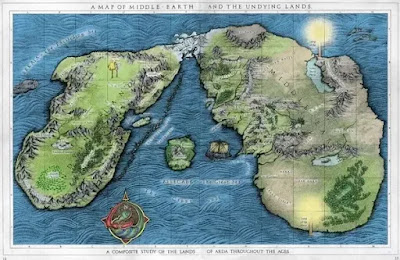Though Tolkien denies any allegory in The Lord of the Rings, it is at time clear that at the very least there are parallels between it and other works, historical, fictional and religious. To me, his figure of Eru Illuvatar is meant, if not as an allegory for the Judeo-Christian God, to remind the reader of Him and have one thinking in that sphere. There are a number of similarities between the two, and to not compare the Creator that Tolkien believed in to the one he created seems a wasted opportunity.
To start, both Eru Illuvatar and God are unique beings. In their worlds, there is no other being like them. They are all-knowing and all powerful, or at least so it seems for Eru and so doctrine states for God. Through their design is the Universe wrought. There are also key differences – Eru explicitly creates the Ainur, heavenly beings who assist him in creation, where God in the most widely accepted accounts of creation does all the work Himself. Nevertheless, heavenly beings at some point do come about in the form of the angels. Another similarity, the one I find most interesting, is the relationship each has with their favored “child” – God’s favored angel, Lucifer, and Eru Illuvatar’s favored Ainur, Melkor.
Between these two figures there are again a number of parallels, even if they are not deliberate allegory. Both Lucifer and Melkor begin as the favored sons of their respective deities. Both have the seed of jealousy in their hearts, and before long both rebel against the will of the highest power. And thus is evil born into the world. Interestingly, both are also most often called by a different name after their rebellion - Lucifer is Satan, and Melkor becomes Morgoth.
There are differences here too, and they are important. While both rebel out of pride, Melkor’s rebellion originally is one of competition, not of rejection. He does not seek to destroy Eru’s works, not at first, but to add his own, better, unplanned creations to the divine song. Only later does he come to despise creation and desire its subjugation and destruction. As far as I have read in the Judeo-Christian tradition, there is no middle step for Lucifer: he goes from favored son to hateful destroyer without the attempt to add his own creation. His pride is different than Melkor’s at the beginning, though they end up in similar places.
The issue around Lucifer and Melkor I find most interesting to discuss is the origin of their pride, and therefore their downfall and the subsequent birth of evil. In the case of Lucifer at least, my understanding of God is that He is all knowing and all powerful. He created all things exactly as they are, and therefore must have created Lucifer to be prideful. Can He, who is omniscient, have made an oversight, a mistake? This seems a contradiction; therefore God must have intentionally made Lucifer the way he is. I have seen many theological reckonings of this, the one that seems most sensible to me is that God created Lucifer to tempt humanity so that the free will he gave humanity would have any meaning. Without the ability to choose evil, the choice to live virtuously is meaningless. If truly He did see and plan for all of time, this is the only explanation that seems to me sufficient, though it is extraordinarily cruel towards Lucifer.
The case of Melkor is more complicated for a number of reasons. For one, while it is implied that Eru Illuvatar is omniscient and omnipotent, it is not to my memory explicitly stated. Importantly, the free will and independence of the Ainur is implied to a degree that the angels’ is not. The Ainur seem to be the children, the companions of Eru whereas the angels are more God’s functionaries. This makes Melkor’s choice more meaningful. It doesn’t have to be preordained by Eru, he can invent it all of his own accord. Instead of the majesty of a vast, inscrutable plan, Eru’s mastery is shown in his effortless inclusion of Melkor’s discordant themes in his heavenly music. He adapts the unexpected and makes it part of the beautiful story that is Creation. Of course, it is entirely possible that Eru did just as it seems God must have, creating Melkor solely so that he would fall and introduce evil, and therefore meaningful choice.
It is also technically possible that the opposite is true, and that God created Lucifer with free will that sparked his rebellion. The issue with this is of course that if God is all-knowing, then he would have known this would happen and then should, in theory, have just not created Lucifer. The doctrinal explanation of the clash of an omniscient God and free will, stemming from Augustine, doesn’t solve this issue entirely but it complicates it to the point of possibility. Augustine states that God’s omniscience is, in effect, knowing all of time without predetermining it. He can see all that will happen, but has not written it. We make our choices, and time progresses, but He sees it all in an instant, as if it was a single moment of time as we perceive it.
Therefore, He could know what Lucifer would do with his free will but not stop it, because that is the meaning of free will. This presents a separate problem, that of inaction. If God knew Lucifer would create evil, and had the opportunity to stop that, why didn’t He? Either he couldn’t stop it, meaning He isn’t all-powerful, or He didn’t, which implies that He wanted evil to exist. A complicated theological problem, and certainly not one I can untangle in 900-1200 words, but to me exactly the kind of thinking Tolkien would’ve wanted in his readers when he wrote a divine Creator so similar to his God, whose favored son creates evil in such a similar way.
—Sam Sobel









